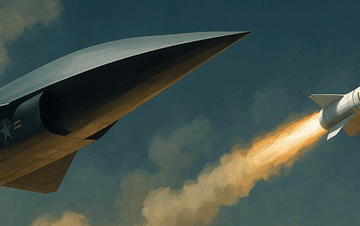The American Enterprise Institute’s (AEI) new report, Building an Enduring Advantage in the Third Space Age, is a well-written report, authored by the well-known and respected Todd Harrison. Found in its pages are several assessments and recommendations on areas such as space launch rates and commercial expansion of the overall satellite constellation, as well as many other items. All of these areas are of great importance and magnitude for building the nation’s space infrastructure to further American advantage on earth and in space.
However, one area the report does not cover is how the United States can ensure the advantages created by an expanding critical space infrastructure will remain “enduring” under direct threat of space attack without the weapons systems capable of deterring or defeating such aggression. Without a US Space Force capable of achieving measurable space superiority against a continual growth in Chinese and Russian space attack forces, new technologies and capabilities for terrestrial advantage will create more targets and vulnerabilities.
At present, there is much to do in space to continue to maintain what advantages and leadership the United States has managed to keep in the past twenty years of passivity and talk. At present the Space Force and its combatant command cousin US Space Command, while capable organizations for enabling terrestrial actions and providing situational awareness of space activities, are fully incapable of addressing the threat of armed aggression in and from space. Having an ability to take a hit and not proactively retaliate in and from space creates more, rather than less, vulnerability for exploitation and weakness in times of conflict. Would the nation take this type of approach with other services? Take the Air Force as an example.
Suppose the US was seeking to maintain its airpower advantage through the improvement of fuel efficiency, navigation routes, wing design, air traffic control modernization, and speed and distance characteristics of aircraft. Meanwhile, the enemy is building vast integrated air defense systems of missiles and fighter-interceptors, and long-range bombers, to take out the industrial and operational infrastructure of American civil and military aviation.
While the US has the advantage of outstanding technology in the air, the adversary fielded an ability to deny, degrade, and destroy that advantage in rapid fashion. Instead of building a US Air Force that fights, the nation responds by building an Air Force that can conduct limited electromagnetic jamming, overhead reconnaissance, and movement of equipment.
The Air Force’s position is that the service can take the hits and replace the airplanes in a reasonable time frame. All the while, in a great-power war, airports, air bases, and aircraft that provide an enduring advantage in economic and military support are now smoking debris. Regardless of the advantage airpower provides in this scenario, the United States possesses no means for strategic attack or air superiority.
This is exactly where the nation is with the Space Force. The urgency of the times is having little effect in shaping the actions of planners or political leaders.
At the low end, the Space Force has a very small number of electromagnetic jammers and geolocation systems. While such a small number was good for rotating them over time into a largely uncontested Middle East operating environment in the Global War on Terror, such numbers are wholly inadequate for requirements in the Indo-Pacific theater, much less the entirety of combatant command requirements worldwide.
The United States lacks options that are known to friends, neutrals and enemies alike with a clear declaratory policy highlighting American willingness and ability to project force in and from space to deter or win a conflict in space. Knowing what is happening in space is important, but there is no such thing as deterrence by attribution. Americans knew the Russians were amassing troops outside Ukraine and communicated that publicly, but Putin still invaded. The United States is pushing for norms of behavior and bans on destructive ASAT testing—to mitigate long-lived debris fields—but Russia and China oppose these efforts and continue to test, deploy, and use their space forces on a near daily basis, as former Vice Chief of Space Operations, General David Thompson, noted before his retirement.
The time has come to fix this and to do so publicly and aggressively. Passivity and resiliency alone will not defend America’s critical space infrastructure and the advantage that it provides. Only with a force projection capability that can achieve space superiority in and from space, as the Chinese and Russians both believe is key to deterrence, can the nation achieve credible deterrence in the minds of our adversaries.
Christopher Stone is Senior Fellow for Space Deterrence at the National Institute for Deterrence Studies and the former special assistant to the Deputy Assistant Secretary of Defense for Space Policy. The views expressed are those of the author and do not reflect the official policy or position of the Department of Defense or the US Government.





My very esteemed NIDS colleague and particular Space Deterrence expert Chris Stone has penned another indispensable, short and to the point essay arguing for stronger American ability to project armed force into and within and even from outer space. I agree totally that only in this way (“Peace Through Strength Beyond the Karmen Line”) can we stand a prayer of deterring superpower adversaries Russia and China from strengthening their own current daunting, years-ahead-of-us space-arms advantages (ASATs, FOBS, Sputnuke, etc.) — which overmatching capabilities then enable/allow them to coerce or even attack us and our allies and friends. Pacifism will not work, nor will setting a “fine example” of restraint. Cultural mirror imaging between us and the CRINKs’ ruthless, violent, repressive and even genocidal dictatorships is a fatal error. Chris uses the appealing, convincing example, of a USAF that is clearly useless for both offense and for defense, to show the still-doubtful among his audience that any further pacifism-isolationism, trivialization, and/or sub-minimalism in U.S. military space power will make sure the Good Guys lose Cold War II.